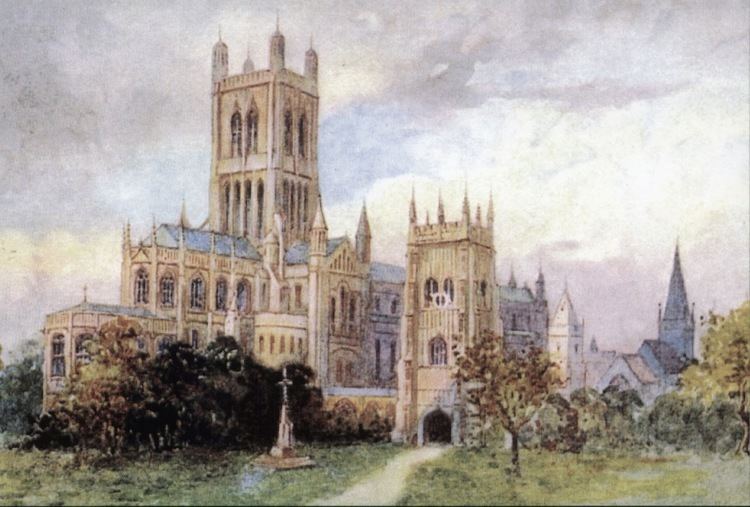 | ||
Similar | ||
Evesham Abbey was founded by Saint Egwin at Evesham in Worcestershire, England between 700 and 710 AD following an alleged vision of the Virgin Mary by a swineherd by the name of Eof.
Contents
- Map of Evesham Abbey Evesham WR11 4BG UK
- Early foundation
- Dissolution
- Excavations
- Relics of saints
- Other burials
- GWR Star Class steam engine
- References
Map of Evesham Abbey, Evesham WR11 4BG, UK
According to the monastic history, Evesham came through the Norman Conquest unusually well, because of a quick approach by Abbot Æthelwig to William the Conqueror. Only one section of walling survives from the actual abbey, although fragments of the chapter house, the bell tower and the gateway remain, which were added later: the chapter house in the 13th century and the bell tower in the 16th century. Simon de Montfort (1208–1265) is buried near the high altar of the ruined abbey, the spot marked by an altar-like memorial monument dedicated by the Archbishop of Canterbury in 1965. The abbey is of Benedictine origin, and became in its heyday one of the wealthiest in the country. During the Dissolution of the Monasteries, the abbey was demolished leaving only the bell tower surviving into the 21st century. Other buildings linked to history of the abbey that survive today are the Almonry and Middle Littleton Tythe Barn.
Early foundation
The year of the foundation of Evesham Abbey (that is, when a monastic community was first established) is problematic. William Tindal (1794) comments that "I have a MS. but without name or reference, which says that he [Ecgwine] began his Abbey in the year 682. This is before he was made bishop, and seems improbable. Tanner [Not. Mon. p.168] says in 701. The date of Constantine’s charter may decide the point as to the consecration of his Abbey, but there is reason to suppose that Egwin began to build as early as the year 702". George May gives 701 as the year that Ethelred conferred on Ecgwine the whole peninsula with the erection of the monastery commencing in the same year.
On the other hand, the year of the consecration derives from the grant of the first privilege to the Abbey from Pope Constantine "written in the seven hundred and ninth year of our Lord’s incarnation." Ecgwine allegedly returned from Rome bearing this charter, which was apparently read out by Archbishop Berhtwald at a council of “the whole of England” held at Alcester, although that meeting was probably fictitious. Thomas of Marlborough records that, in accordance with the apostolic command, a community of monks was then established (meaning the foundation has also been dated to 709):
"When the blessed Ecgwine saw that longed-for day when the place which he had built would be consecrated, and a monastic order established to serve God in that place, he then abandoned all concerns for worldly matters, and devoted himself to a contemplative way of life. Following the example of the Lord by humbling himself, he resigned his bishop’s see, and became abbot of the monastery."
The alleged charter of Ecgwine (purportedly written 714) records that on the feast of All Saints “Bishop Wilfrid and I consecrated the church which I had built to God, the Blessed Mary, and to all Christ’s elect”. The feast of All Saints became established in the West after 609 or 610 under Pope Boniface IV; its observance on 1 November dates from the time of Pope Gregory III (died 741). A Bishop Wilfrid was Egwin’s successor to the see of Worcester (though he is sometimes confused with Wilfrid, Archbishop of York, who died c. 709).
Although the exact year of the foundation remains unclear, it has sometimes been assumed that the date of the abbey's consecration was the feast of All Saints in 709. That the consecration occurred on this feast day would provide a neat connection with All Saints Church. That Abbot Clement Lichfield lies buried beneath the Chantry Chapel, now known as the Lichfield Chapel in consequence, provides the link to the closing days of the life of the abbey.
Dissolution
During the Dissolution of the Monasteries of the 16th century, on its surrender to the king in 1540, the abbey was plundered and demolished. Only the bell tower survives. The coat of arms of Evesham Abbey is still used in modern times as the crest of Prince Henry's High School, Evesham.
Excavations
The antiquary Edward Rudge began excavations of the abbey, on parts of his property, between 1811 and 1834. The results were given to the Society of Antiquaries of London, illustrations of the discoveries were published in their Vetusta Monumenta with by a memoir by his son, Edward John Rudge. Rudge commissioned an octagon tower for the site of the battlefield in 1842, to honour Simon de Montfort, earl of Leicester.
Relics of saints
Other burials
GWR Star Class steam engine
One of the Great Western Railway Star class locomotives was named Evesham Abbey and numbered 4065. It was subsequently rebuilt as a Castle class locomotive being renumbered as 5085 while retaining the name Evesham Abbey.
